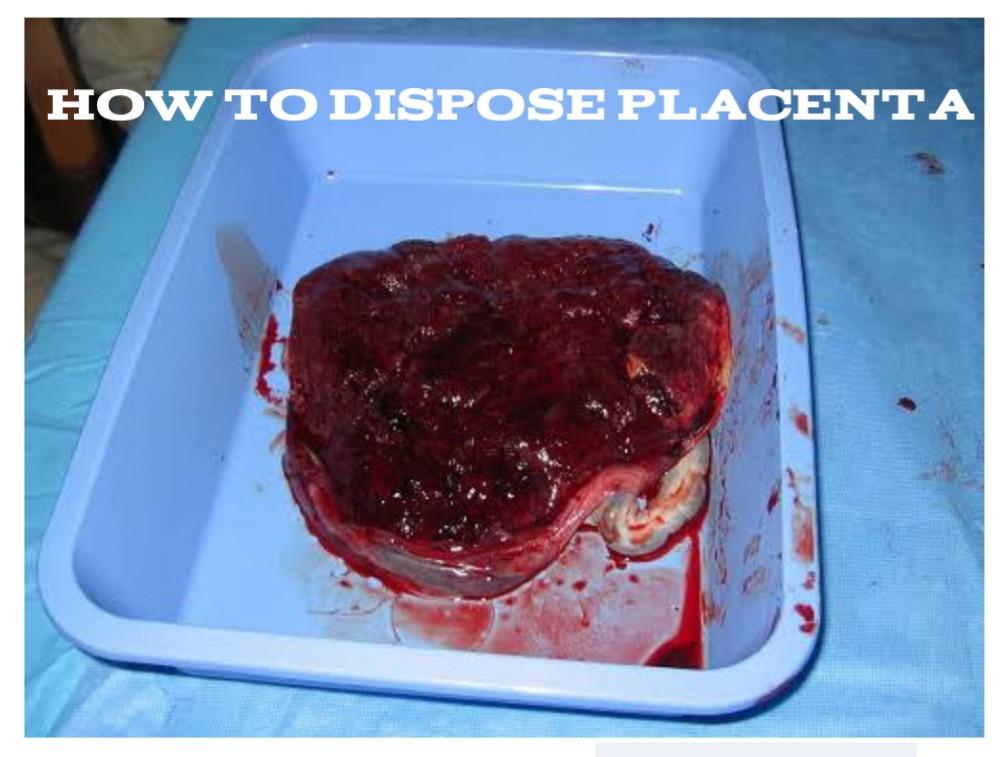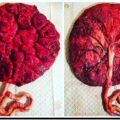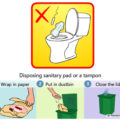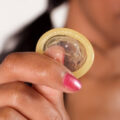The placenta is an organ that develops in your uterus during pregnancy. This structure provides oxygen and nutrients to your growing baby and removes waste products from your baby’s blood. The placenta attaches to the wall of your uterus, and your baby’s umbilical cord arises from it. The placenta is expelled from your body after the birth, usually about 5 to 30 minutes after your baby is born. This is called the third stage of labour. After the baby is born you will continue to have mild contractions. You will have to give one more push to deliver the placenta.
How To Dispose Placenta In Nigeria
Religion, culture and superstition plays a very important role when it comes to placenta disposal in Nigeria. Nevertheless when it comes to public health the only considerations are hygiene and community health because simply throwing it out in the garbage is unhygienic and is going to attract wild animals, maggots, flies and eventually disease. There are several ways to dispose placenta after child birth here is how best to dispose a placenta after delivery:
Burying the placenta
Most cultures in Nigeria observe this disposing method. In Islam, the placenta is buried because it is believed that “from the (earth) did We Create you, and into it Shall We return you” (The Noble Quran, 20:55). Outside Nigeria many cultures, including the Navajo Indians and New Zealand’s Maori, bury the placenta to symbolize the baby’s link to the earth. The placenta can be buried in the backyard or near by bush but should not be buried in a location likely to contaminate a domestic water supply, near a river or on public land. If you decide that you do not want to bury the placenta, it cannot be disposed of in a domestic waste bin. Generally it takes around 10 days for a buried placenta to decompose.
Burning the placenta
Another method adopted by many families in Nigeria when dealing with placenta is to burn it. The placenta is often burned with straw, chaff, wood or charcoal fire until only the ashes are left. Depending on family and region, the ashes of the placenta were either washed away in running water or buried underground, but in any case the placenta was first burned.
Medical Disposal
Most women who give birth in government controlled hospitals don’t have to bother about placenta disposal. In most cases the hospitals handle this for them. Hospitals treat placentas as medical waste or biohazard material. The newborn placenta is placed in a biohazard bag for storage. Some hospitals keep the placenta for a period of time in case the need arises to send it to pathology for further analysis. Once the hospital is done with the placenta, it is put on a truck with all the other medical waste accumulated at the hospital for proper disposal. In some hospitals, placentas are incinerated on site. Those who give birth at home may return it in a sealed container to the hospital for disposal.
Do NOT Flush the Placenta Down the toilet
Flushing placenta into the sewage system is an option you should never consider. Apart from the fact that it can block the system, it will take a longer time to decay and possibly lead to the spread of disease. Obstructed sewage can cause typhoid and campylobacteriosis which are infectious diseases. Children are more likely to get infected with typhoid and other skin conditions.
Eating Placenta is NOT Safe
From a public health stand point eating placenta is not healthy. Forget what you hear from uneducated celebrities, eating placenta could be your one way ticket to the hospital emergency room. The placenta serves as a filter, keeping dangerous waste away from your baby. But some waste could still be contained in the placenta after childbirth. While the placenta is in uterus, it’s almost like a filter, filtering out things the baby shouldn’t get, including bacteria. Any infection in your blood lives in your placenta, drying and converting them to capsules is not safe either.
A 2016 report from the Centers for Disease Control and Prevention (CDC) details a case involving a baby who was born healthy and without complications, but soon developed respiratory issues. When doctors examined the baby, they discovered the presence of B Streptococcus agalactiae (GBS) bacteremia, a dangerous blood infection also known as group B strep. Eventually doctors linked the baby’s infection to placenta eating; the mother was consuming it in capsule form, and she appeared to pass the infection along to the baby while breastfeeding. The team examined the placenta capsules and confirmed this link: The pills were full of GBS, which can cause babies to develop sepsis (infection of the blood), pneumonia (infection in the lungs), and meningitis (infection of the fluid and lining around the brain). While this is a rare case, mothers should still take caution when dealing with Baby’s health.
Common Myths About Placenta Eating
Myth #1: It gives new moms more energy.
Some new moms think placenta ingestion will boost their energy during recovery. The placenta does in fact contain vitamins and minerals including iron and B12. Metabolic studies in moms who consume their placenta versus those who don’t, however, have shown no significant difference. Moms who do report more energy from placentophagy may likely be experiencing a placebo effect, feeling empowered by their decision.
Myth #2: It increases milk production.
In studies on this subject, no benefit was noted among women who consume their placenta. Milk production is actually stimulated after delivery by the rise of prolactin levels, not by hormones like estradiol and progesterone thought to be present in the placenta.
Myth #3: It decreases the risk of postpartum depression.
A common misunderstanding is that hormones contained in the placenta will help prevent postpartum depression. Some theorize hormones depleted during childbirth can be quickly replenished by ingesting the placenta. Studies have actually shown little to no difference in postpartum depression risk between women who ingest their placenta and those who don’t, even among women with a history of mood disorders.
Myth #4: It provides a nutrient boost for mom and baby.
A healthy, balanced diet will generally provide new moms with all the fiber, protein and nutrients they need. Adding a multivitamin or placenta will not contribute significantly to missing nutrients from the diet. In less developed countries, however, diet alone may not be an adequate source for nutrition.
Myth #5: It will help reduce pain and speed healing.
Some evidence has been found in animal studies to support this theory. However, there is no indication to date for human benefit.
Myth #6: The placenta is safe for consumption.
There are just so many reasons why the placenta should not be consumed. To start with, the placenta is not a sterile organ. It contains toxins like mercury and lead, as well as potential bacteria and viruses. It even has its own bacterial culture. Any infection during labor will, most likely, be present in the placental tissue. Cooking the placenta decreased these pathogens, but cannot get rid of them completely.
Science-based studies of placentophagy to date indicate the risk of placenta consumption is far greater than any benefit, as bacteria and toxins can be passed to mom and baby (if nursing). There is even a documented case of an infant contracting group B Streptococcus sepsis (GBS) from contaminated placenta capsules. ALSO SEE: How to Dispose Sanitary Pad in Nigeria
Final Thoughts
Dispose your child’s placenta properly, only cannibals eat human flesh or remains, exposing yourself and your baby to toxins and disease causing microorganism by eating your placenta exposes you and your child to disease. Congratulations on the Birth of your child







